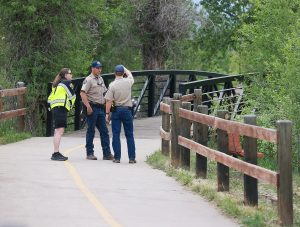Irish pipes play exotic music
Since Gary Burman was a child, he has played the piano, guitar, trombone, harmonica, recorder, mandolin, mandola and several other instruments.
But these days, Burman has traded in his array of musical talents to tackle one exotic and challenging instrument that he hauls around in a bright yellow toolbox: the uilleann pipes, otherwise known as the “Irish organ.”
“This whole obsession with the pipes has it, so I don’t really want to touch anything else,” said Burman, who emphatically defines himself as a beginning piper. “A lot of people think about cracking their beer when they get home, but I look forward to my pipes.”
“Uilleann” is Gaelic for “elbows.” The uilleann pipes, a descendant of the bagpipes, can cover two octaves and include a bag that is blown by pressure from the player’s elbow, a bellows that is not unlike one used for a fireplace, a “chanter” with a reed similar to an oboe, and long pipes called drones and regulators.
The uilleann pipes have a rich, ancient sound that resonates in the musician and the audience. Its deep, hypnotic tones reverberate around the listener and are equally worthy of a meditation or an Irish jig.
“It’s like sitting in the center of a circle of sound,” Burman said. Sometimes the sound is smooth like a whistle, but the pipes often emit chirps and squeaks at the most unexpected moments, he said. “You have to not be afraid of embarrassing yourself with the squeaking. There’s no telling what pipes will do.”
Burman admits the pipes seem a “bizarre” instrument by modern American standards. There are only about a dozen people in Colorado who play the pipes, learning their techniques from one another, CDs, DVDs, books and by studying Web sites. Last month, Burman and a few of his fellow pipers got some tips from all-Ireland champion piper Ivan Goff, who taught a workshop for Colorado uilleann pipers between appearances with Eileen Ivers and Immigrant Soul.
The uilleann pipes were developed in 17th century Ireland after the English outlawed bagpipes, which had been used in warfare since Roman times. The uilleann pipes are quieter than bagpipes, and they enabled the Irish to take their music indoors to the pubs and social dances instead of out for death and destruction, Burman said.
Because the uilleann pipes don’t require the mouth to play, the piper is able to sing, recite poetry or enjoy a beer while playing the pipes, Burman said.
The uilleann pipes are one of two instruments that are truly of Irish origin — the second being the bodhran, or traditional Celtic drum. In the early part of the 20th century, playing the pipes had become a lost art with few pipers and almost no one building the instruments, Burman said.
In the past few years, piping has seen a revival, and there are about 20 people making quality pipes around the world, he estimated.
Burman’s set of uilleann pipes is a half set that was built by two instrument builders between 35 and 40 years ago. He has been playing them at the open mic night at Mahogany Ridge Brewery and Grill and during the “ceilis,” traditional Irish folk dances, that gather at Northwest Ballet the last Friday of each month. Burman said he is eagerly looking forward to seeing Eric Olson, one of the nation’s top pipers, perform at the Longs Peak Scottish/Irish Highland Festival next month.
“If people are interested in the pipes, by all means call me,” Burman said. He said Irish music has always been his passion, and while there isn’t a whole lot of money to be had in Irish folk music, there is a special kind of brotherhood and sisterhood among pipers, he said. “If this could grow into an Irish session once a month, I’d be in heaven.”
Burman can be reached via e-mail at garyburman@frii.com.

Support Local Journalism

Support Local Journalism
Readers around Steamboat and Routt County make the Steamboat Pilot & Today’s work possible. Your financial contribution supports our efforts to deliver quality, locally relevant journalism.
Now more than ever, your support is critical to help us keep our community informed about the evolving coronavirus pandemic and the impact it is having locally. Every contribution, however large or small, will make a difference.
Each donation will be used exclusively for the development and creation of increased news coverage.









